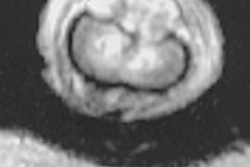Opera singers who perform in the wrong vocal range could find their careers ended long before the fat lady sings. Medical imaging may be able to help, however. Because MRI can visualize human vocal cords noninvasively, Italian researchers say it can assist voice teachers in selecting the proper range for professional opera singers.
Dr. Marco Di Girolamo, a self-confessed opera lover and radiologist at the University of Rome La Sapienza, presented his study at the RSNA conference on December 1.
The study sought to demonstrate that vocal cord length differs for sopranos, mezzo-sopranos, tenors and basses, and other singers. When a singer performs out of his or her normal register, it can set up a cascade of anatomical changes that may lead to development of vocal cord nodes and prematurely end a singer's career, he explained.
Professional singers often train with vocal coaches in order to develop their voices, and they can be incorrectly classified, Di Girolamo said.
"In almost one in ten cases at the beginning of a singer's artistic career, the voice teacher has a difficult time correctly classifying the singer's tessitura, or vocal register," he said.
The study group consisted of 26 singers from the chorus of the Opera Theater of Rome. T2-weighted turbo spin-echo (TSE) axial scans at the level of the larynx were obtained in order to assess the length and diameter of the vocal cord. TSE T2-weighted coronal scans were taken at the level of the mouth in order to establish the diameter of the palate when the singer was resting.
A midsagittal scan at the level of the oro-pharyngeal cavity and a coronal scan at the level of the pharynx lumen using a turbo field-echo sequence were also obtained.
Finally, the singers were asked to perform a prolonged vocalization of the fundamental vowels (a, i, and u) using their normal tonality. Di Girolamo and his co-authors measured the area of the mouth and pharynx lumen on midsagittal scans and the area of the pharyngeal lumen on the coronal scans.
The results showed a correlation between the surface of the vocal cord and the configuration for the vocal tract with the tone of vocal emission. Bass, baritone, contralto, and mezzo-soprano singers had a long vocal cord and a wide vocal tract. Singers with high-pitched voice emission -- tenor, soprano -- had a short vocal cord and a small vocal tract.
If the singer performs for a long time in the wrong register, nodes can form. Resting the voice can help relieve the strain, but sometimes surgery is required to remove the nodes, he said.
"Not only can it hurt the voice if the singer tries to sing too low or too high for his or her appropriate tessitura, but once someone starts singing at a lower range than he or she should, it will be difficult to switch to the higher ranges."
Laryngoscopy also can be used to evaluate the vocal tract. However, it is invasive, and it can't generate as precise a measurement of vocal cord size, Di Girolamo said.
"MRI is the only diagnostic imaging technique that can precisely measure the anatomical features without the risk associated with radiation," he said.
Dr. Hedvig Hricak, radiology department chair at Memorial Sloan-Kettering Cancer Center in New York City, said Di Girolamo's study is consistent with other evidence that singing or talking in the wrong register can cause problems.
"It is known that when women public speakers attempt to speak in a lower register in order to sound more professional, they can develop hoarseness and vocal cord nodes," she said.
By Edward SusmanAuntMinnie.com contributing writer
December 7, 2000
Click here to post your comments about this story. Please include the headline of the article in your message.
Copyright © 2000 AuntMinnie.com


.fFmgij6Hin.png?auto=compress%2Cformat&fit=crop&h=100&q=70&w=100)





.fFmgij6Hin.png?auto=compress%2Cformat&fit=crop&h=167&q=70&w=250)











